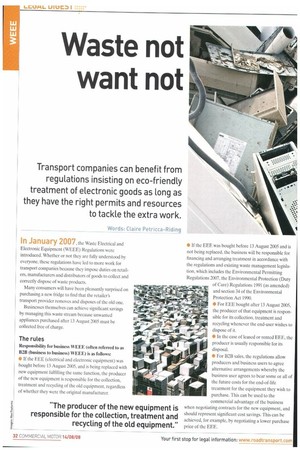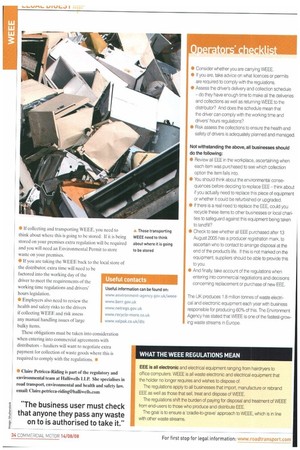Waste not want not
Page 32

Page 33

Page 34

If you've noticed an error in this article please click here to report it so we can fix it.
Transport companies can benefit from regulations insisting on eco-friendly treatment of electronic goods as long as they have the right permits and resources to tackle the extra work.
Words: Claire Petricca-Riding In January 2007, the Waste Electrical and Electronic Equipment (WEEE) Regulations were introduced. Whether or not they are fully understood by everyone, these regulations have led to more work for transport companies because they impose duties on retailers, manufacturers and distributors of goods to collect and correctly dispose of waste products.
Many consumers will have been pleasantly surprised on purchasing a new fridge to find that the retailer's transport provider removes and disposes of the old one.
Businesses themselves can achieve significant savings by managing this waste stream because unwanted appliances purchased after 13 August 2005 must be collected free of charge.
The rules Responsibility for business WEEE (often referred to as B2B flimsiness to business) WEEE) is as follows: • If the FEE (electrical and electronic equipment) was bought before 13 August 2005, and is being replaced with new equipment fulfilling the same function, the producer of the new equipment is responsible for the collection, treatment and recycling of the old equipment, regardless of whether they were the original manufacturer. • If the EEE was bought before 13 August 2005 and is not being replaced. the business will be responsible for financing and arranging treatment in accordance with the regulations and existing waste management legislation, which includes the Environmental Permitting Regulations 2007, the Environmental Protection (Duty of Care) Regulations 1991 (as amended) and section 34 of the Environmental Protection Act 1990.
• For EEE bought after 13 August 2005, the producer of that equipment is responsible for its collection, treatment and recycling whenever the end-user wishes to dispose of it.
• In the case of leased or rented EEE, the producer is usually responsible for its disposal.
• For B2B sales, the regulations allow producers and business users to agree alternative arrangements whereby the business user agrees to bear some or all of the future costs for the end-of-life treatment for the equipment they wish to purchase. This can be used to the commercial advantage of the business when negotiating contracts for the new equipment, and should represent significant cost savings. This can be achieved, for example, by negotiating a lower purchase price of the EEE. Duty of Care Aside from specific WEEE considerations, business users have to ensure that any waste produced is handled safely and within the law — this is called 'Duty of Care'. It means that the business user must check that anyone they pass any waste on to is authorised to take it. If the business user does not check that the waste business is authorised to take the waste, and it is illegally disposed of, the business end user could be held responsible. Duty of Care has no time limit, it runs until the waste has either been finally disposed of or fully recovered. What are the implications for the transport sector? The distributors (including manufacturers and retailers) are likely to be clients of transport operators. Distributors have three options under the Regulations in which to take back WEEE. These are: • To join the 'distributor take-back' scheme, which is operated by Valpak • To operate a free 'in-store take-back' scheme • To set up their own 'distributor take-back' scheme Valpak scheme If the distributor joins the Valpak scheme, then there is no need to be concerned as collection of the WEEE will he arranged by it.
If, however, your transport business is delivering EEE to an end user in accordance with a delivery contract with the distributor, then they may wish, as part of that contract, for your business to collect the waste equipment being replaced by the new equipment.
Whenever a transport business deals with WEEE, it needs to be aware of the following: • WEEE is classified as waste. Anybody wishing to transport waste is required to hold a waste carrier's licence, which needs to be registered with the Environment Agency, and to comply with the Duty of Care requirements of holding such a licence. If no registration for a waste carrier's licence exists and the agency finds a vehicle to be carrying WEEE the business could be prosecuted. A waste carrier's licence costs £149 and must be renewed after three years. It must be said, however, that this regime is currently the subject of a consultation by Defra and may change next year. • If collecting and transporting WEEE, you need to think about where this is going to be stored. If it is being stored on your premises extra regulation will be required and you will need an Environmental Permit to store waste on your premises.
• If you are taking the WEEE back to the local store of the distributor, extra time will need to be factored into the working day of the driver to meet the requirements of the working time regulations and drivers' hours legislation.
• Employers also need to review the health and safety risks to the drivers if collecting WEEE and risk assess any manual handling issues of large bulky items.
These obligations must be taken into consideration when entering into commercial agreements with distributors hauliers will want to negotiate extra payment for collection of waste goods where this is required to comply with the regulations. • • Claire Petricca-Riding is part of the regulatory and environmental team at Halliwells LLP. She specialises in road transport, environmental and health and safety law. email: Claire.petricca-ricling@halliwells.com • Consider whether you are carrying WEEE.
• If you are, take advice on what licences or permits are required to comply with the regulations.
• Assess the driver's delivery and collection schedule do they have enough time to make all the deliveries and collections as well as returning WEEE to the distributor? And does the schedule mean that the driver can comply with the working time and drivers' hours regulations?
• Risk assess the collections to ensure the health and safety of drivers is adequately planned and managed.
Not withstanding the above, all businesses should do the following: • Review all EEE in the workplace, ascertaining when each item was purchased to see which collection option the item falls into.
• You should think about the environmental consequences before deciding to replace EEE think about if you actually need to replace this piece of equipment or whether it could be refurbished or upgraded.
• If there is a real need to replace the EEE, could you recycle these items to other businesses or local charities to safeguard against this equipment being taken to landfill?
• Check to see whether all EEE purchased after 13 August 2005 has a producer registration mark, to ascertain who to contact to arrange disposal at the end of the product's life. If this is not marked on the equipment, suppliers should be able to provide this to you.
• And finally, take account of the regulations when entering into commercial negotiations and decisions concerning replacement or purchase of new EEE.
The UK produces 1.8 million tonnes of waste electrcal and electronic equipment each year with business responsible for producing 60% of this. The Environment Agency has stated that WEEE is one of the fastest-growing waste streams in Europe.
































































































































































